-
Paul Greengrass: CAPTAIN PHILLIPS (2003
PAUL GREENGRASS: CAPTAIN PHILLIPS (2013)
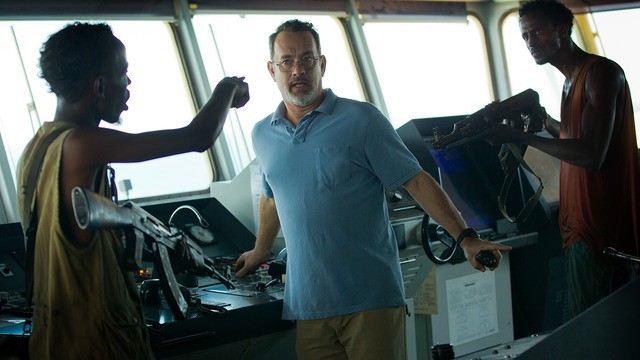
Barkha Abdi and Tom Hanks in Captain Philips
Greengrass and Hanks' Somali hijacking film favors action and emotion over specifics
[S P O I L E R S]
Paul Greengrass' Captain Phillips is a movie based on a 2009 incident of a container ship with a US captain by this name that Somali fishermen attempted to hijack, the MV Maersk Alabama , ironically then carrying 5,000 tons of African relief supplies. Compare the recent Danish film directed by Tobias Lindholm, A Hijacking (ND/NF 2013), based on several similar incidents, and combining focus on shipboard events involving Danish crew and Somalis, with tense ransom negotiations by the shipowners back at home. The Hollywood film eschews the corporate POV at home to which A Hijacking constantly returns but adds a famous star and, for action drama, a military operation (which actually occurred) to free the ship and subdue the young Somalis. Real negotiations never actually get going between pirates and shipowners of the huge Maersk container ship captained by Captain Richard Phillips (Tom Hanks). Why would they -- when a battleship and the Navy SEALS can be called in to sweep away the Somalis? This reportedly was the first seizure by pirates of a ship flying the American flag since the early 1800's -- but since It was the sixth vessel in a week to be attacked by pirates who'd gotten ransoms in the tens of millions of dollars, maybe the US overkill was a wise corrective move.
But seeing Greengrass' film after Lindholm's may leave you feeling cheated of the edgy drama of bargaining when big property values and human lives are at stake -- which winds up being the suspenseful process depicted in Lindholm's film, and has been happening a lot, in waters where Somalis lurk.
Maybe the Somalis this time aren't experienced enough, but the Americans resort to trickery from the start, while in A Hijacking the Danes are just out to make the toughest deal they can. Greengrass, who made the strong docudramas Bloody Sunday and United 93 and the highly entertaining second and third Bourne episodes, is definitely a world class action movie director. But in its emphasis on action Captain Phillips loses a lot of characterization detail and narrative specifics. What you do have is Tom Hanks, and despite a mundane beginning, he delivers some profoundly open emotion at the end in enacting the captain's state of nerves and devastation when his ordeal is over.
Each of these two films is well done in its way. The higher profile Tom Hanks film will get as good reviews as A Hijacking and perhaps Oscar attention but it's not yet clear how big it will be at the box office. Mainstream viewers may be put off not only by the lack of definition or subtlety among the Somalis but also a pretty muddled middle section and finale and a lot of subtitles, as well as the lack of any name actor besides Hanks.
Whereas viewers of A Hijacking will remember the slow, suspenseful negotiations, the company head and his hired advisor versus the pirates and the dire threats, tough dealing, and brutal consequences on the Somali pirates' side. In the Danish film, the Somalis are pros at their game. In the American one, the Somalis are inexperienced young hotheads who constantly fight among themselves. In Captain Phillips the American piracy experts and naval support's plans aren't fully revealed to us. Nor do we even know quite what they actually do other than lie to the Somalis and kill most of them. The contrast seems to fit differences between a small country's need to use limited means to best advantage versus American exceptionalism. The Danes make a deal; the US uses brute force.
Hanks has suggested he found an interpretive key to the real Captain Phillips, of Vermont (whose New England accent he sporadically evokes), when informed by Phillips' wife that he turns into a different, no-nonsense, ultra-serious man when he's in command of a ship. Actually, though, in the very hasty initial at-home segment, Hanks' captain and his wife (a barely glimpsed Catherine Keener) both seem pretty solemn, talking of little but how dangerous his work is and how much they both wish each time for it to be over.
Once the Somalis approach the ship, Phillips' strategy is to hide most of his crew in the engine room. He stalls the Somali's de facto leader Muse (Barkhad Abdi), getting broken glass thrown down at the engine room entrance so the barefoot youngest Somali, Bilal (Barkhad Abdirahman) gets a badly cut foot. The other personality that emerges among the hijackes is the wild-eyed Elmi (Mahat M. Ali), a tall hothead who constantly pushes for more violent and extreme action.
In the event, with these problems and the captain's trickery and delays, Muse doesn't have much of a chance to negotiate a ransom, though that, as in the Danish film, is what the Somalis were aiming for. None of the Somalis on the Alabama comes close to the cool, arrogant, experienced Omar (Abdihakin Asgar), who does the hijackers' negotiating in Lindholm's film. In Captain Phillips, the situation is dangerous but one-sided. To mix metaphors, Greengrass' Somalis are loose canons but not tough cookies.
To fit Greengrass' area of excellence, everything in Captain Phillips is boldly physical and visual. There's a noisy, exciting scene on shore at the outset showing the Somalis' chaotic selection process for the random hijacking mission, and many shots of the Maersk ship and the two skiffs, reduced to one when Phillips, in his first bit of trickery, scares the others off by broadcasting faked arrangements with a police vessel. The unique event in the Captain Phillips situation is Muse's decision to take the captain off the ship in a sealed lifeboat. And then as in a Bourne movie we switch back and forth between control centers, including the special fighter ship that supervises a Navy SEALS operation that is never quite made clear.
Shut in the closed, claustrophobic lifeboat with the crazed Somalis, Phillips must endure a hair-raising and ear-shattering attack from the US Navy and weapons fired off by the hijackers, including a small rocket right next to him -- noise almost as bad as this movie's thumping, bone-shaking score by Henry Jackman. The most memorable moment in the film is when Phillips is taken on board the rescue ship to a silent sick bay where a nurse tries to calm him. Hanks does a unique impression of a man shaken, terrified, and speechless after a violent ordeal.
As Todd McCarthy notes in Hollywood Reporter, this is another one of an elite group of fall-release "survival stories," including Gravity, 12 Years a Slave, and All Is Lost, the latter two also included in the NYFF. Each has its very different and valid directorial style and feel. But I'd ultimately agree with blogger Joe Bendel of j.b.spins" who found Greengrass' hijacking film inferior to Lindholm's in almost every respect, its second half clearly weaker than its first. This isn't up to Greengrass' best work.
Captain Phillips, 133 mins., a Sony Pictures Studios release, had its world premiere at the gala opening night of the New York Film Festival 27 Sept. 2013, when it was screened for this review; will also be in the London Film Festival. Screenplay by Billy Ray, based on the book by Richard Phillips with Stephan Talty. US release 11 Oct., UK, 18 Oct.
Last edited by Chris Knipp; 01-02-2015 at 06:06 PM.
-
Declan Lowney: ALAN PARTRIDGE (2013)
DECLAN LOWNEY: ALAN PARTRIDGE (2013)
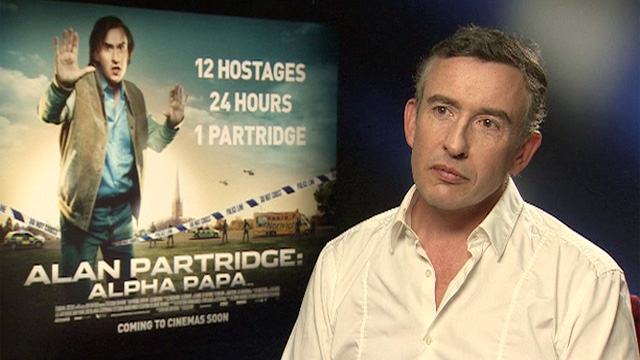
Steve Coogan
Steve Coogan triumphs as his goofily egocentric alter ego
This movie is a one-time big-screen outlet for Steve Coogan’s comic creation, originally (1997) radio, later TV. Alan Partridge is a Norwich-based radio emcee. The vain and obliviously tactless character in this iteration is called upon to serve as an intermediary when the radio station North Norfolk Digital" bought out by a multinational conglomerate and is about to be re-branded as "Shape." The station is subsequently subjected to a siege by Partridge's Irish colleague, Pat Farrrell (Colm Meaney) when he's let go in the process. "I'm Alan Partridge" was originally a BBC situation comedy starring Coogan with two series of six episodes each were produced — the first in 1997 and the second in 2000 (though Alan Partridge seems to go back to 1995).
This film, which got its North American debut at the prestigious and selective New York Film Festival is nonetheless very broad comedy material, and very English as well, as Coogan was first to point out at the New York festival Q&A. Coogan is an inspired comic, and he's most known in the US from performances in several films directed by Michael Winterbottom. Winterbottom's Tristram Shandy: A Cock and Bull Story, featuring Coogan, was part of the 2005 NYFF. Before that, Coogan had a lead role in perhaps Winterbottom's most celebrated feature, 24 Hour Party People (2002) Coogan was also very funny more recently in Winterbottom's The Trip, again a big-screen version of comedy from the Tube. Somewhat to his chagrin, Coogan often has minor roles in feature films, but he's nearly always very droll in them. I recently enjoyed him a lot, perhaps from knowing there's more there than shows on the surface, as the irresponsible art dealer husband Beale in an American film, Scott McGehee and David Siegel's contemporary version of Henry James's What Maisie Knew.
This feature film version of Alan Partridge relies on extreme situations and sometimes crude, scatological, or slapstick humor. It's more a series of jokes than anything else. It seeks, more or less successfully, to strike a balance between the triviality of a radio or TV sit-com and a serious film. It doesn't stray very far from its basic venue, the radio studios (which eventually become surrounded by onlookers, TV cameramen, journalists, and police). It stays parochial. Coogan explained that a comedy involving a siege by Al Qaeda was included, but that would have strayed onto dangerous ground. In the film Partridge warns a colleague not to joke about Islam. Christianity a lot, sure; Judaism a little. Islam, never.
Despite its broadness, Alan Partridge is anything but just sight gags. It's most of all a lot of profane, outrageous, rapid-fire verbal humor -- an intricate kind the Brits have a special knack for. It's therefore not a surprise to see the name of Armando Iannucci among the writers (who include Peter Baynham, Neil Gibbons and Rob Gibbons) and to remember that Coogan was included in In the Loop (2009), and Ianucci was deeply involved in the very fast, very witty, very political The Thick of It (2005).
This movie is sort of political, though not on the level of those two TV series/films: it's about a corporate takeover. That's economics, anyway. But the event is largely a pretext to display Partridge's ego. When he learns a downsizing is coming under the new owners of the radio station, he fingers Pat Farrell, and Farrell indeed gets cut. The irony (or one of them) is that Partridge should be sent in to placate the shotgun-wielding Farrell, when the latter is pretty likely to catch on at some point that this mediator is the root cause of his humiliation. Meanwhile Partridge, whose ego is forever way bigger than his talent, sees how his new role in the news as a local savior has greatly increased his fame, and concludes it's well worth his while to prolong the siege of the station as long as possible so he can stay in the limelight.
The many secondary characters are all sterling in this film, as has always been typical of British comedy and cinema. However the problem remains that however hilarious the lines and risible the action this is an enlargement of small screen material to a space where it looks a bit pushed. Certainly this is by no means an unworthy version of Coogan's most famous comic character, but it remains true that the character is better and larger than anything on screen. (The Irish-born director Declan Lowery has primarily worked in TV.)
Whether this is a movie worthy to be included in the elite and selective New York Film Festival is a question to be left up to the historians. Certainly the NYFf has included less important and less worthy stuff, and Coogan is an alumnus. The choice also fits in with the new Program Director Kent Jones's (or this year's Jury's) revealed penchant for English comedy, resulting in inclusion of Roger Mitchell's Le Week-End, a sardonic senior citizen relationship comedy, and Richard Curtis's sci-fi fantasy rom-com, About Time. Each fills a different space in the British comedy spectrum.
Alan Partridge (original UK title Alan Partridge: Alpha Papa), 90 mins., debuted in the UK in July and August; its North American premiere is in the New York Film Festival at Lincoln Center, where it was screened for this review.
Last edited by Chris Knipp; 01-02-2015 at 06:08 PM.
-
Kiyoshi Kurosawa: REAL (2013)
KIYOSHI KUROSAWA: REAL (2013)
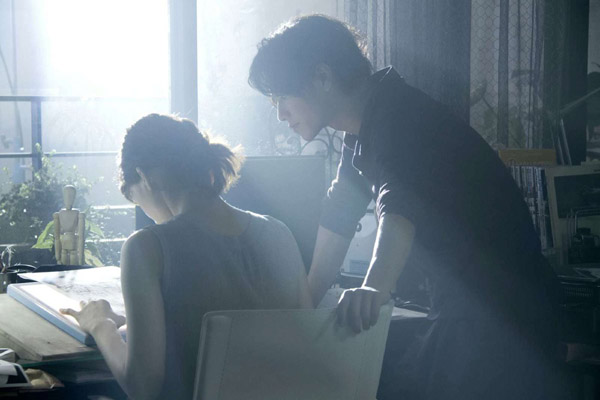
Haruka Ayase and Takeru Satoh in Real
A muddled romance from the other Kurosawa
Real is Kiyoshi Kurosawa's first feature film since Tokyo Sonata( (2008). And it's beginning to seem like a very long time since the director's distinctive yet wholly Japanese horror films, The Cure (1997) and Pulse (2001). Kurosawa's 2012 TV mini-series Penance (SFIFF '13) was finely crafted and highly watchable but somehow the original distinctiveness and promise were lacking; and for that matter despite its garnering perhaps justified praise in the West, Tokyo Sonata (NYFF '08) wasn't an altogether original idea. This one isn't either, and it presents more wan material. Real delves into a Matrix-like connecting up of separate consciousnesses, only this time the consciousnesses are just two. They belong to young lovers who live in a nice apartment in Tokyo. One is in a coma, while the other tries to help by participating in a fancy neurological treatment method known as "sensing." So we get a romance, with fantasy and science fiction.
What could be more Japanese than the circumstances: a manga artist obsessed with work and unable to cope with the world outside the drawings, suicidal and obsessed with childhood? Kurosawa achieves a delicate look, using delicate-looking actors. The result is a film that's nicely crafted, with some good monster special effects, moirée links, and manga fantasy-corpses; but it's repetitious and overlong, taking forever to arrive at a long-obvious finale, flipping back and forth too often along the way. To Matrix and Inception are added Freudianism and a touch of Jurassic Park which really is more a reference to Japanese Fifties monster movies, which Kurosawa gets to do over with state-of-the-art CGI, but limp results. And to top it off this premise was already more intensely dealt with very recently in Lithuanian Kristina Buozyte's Vanishing Waves.
A young couple, Koichi (Takeru Satô) and Atsumi (Haruka Ayase) were childhood friends, now young adult lovers, who pledge to be together forever. One, now, is in a hospital in a coma after a failed suicide attempt. The other submits to the "sensing" process whereby the two's brains are connected, in hopes of finding why the act was done and restoring normal consciousness. "Real" is a giveaway title that warns you: you're not supposed to know what is and isn't. Who is the manga artist, and who is the neurologist? Who's in the coma, and who's delving into the unconscious lover's mind? Is any of this happening? "You can be in my dream if I can be in yours" Bob Dylan said. But who's dreaming?
Whatever the answers to these questions, you are in for a lot of visits to the couple's apartment and a lot of trips to an island where they both lived for a few years as kids. You're going to get a lot of glimpses of a little boy drenched with water. You're going to go hunting repeatedly for a childish sketch of a Plesiosaur that was unusually well executed. This for some reason might get the manga artist's confidence back. As Koichi, Takero Satoh is a pretty male ephebe type always dressed in loose cut-off paints, who draws more attention and gets more screen time than Haruka Ayase as Atsuko, the girl, and has elaborate hair that is dramatically askew in key scenes. After a while his hair began to seem more interesting than most of the rest of the movie.
It seems "sensing" leaves you with "side effects," like LSD. You may see things when returned to normal consciousness. And so the line between "real" and "unreal" begins to become blurred. The trouble is that Kurosawa has eventually blurred too many of his lines, to the point of not caring. And he has substituted a fairyland supernaturalism for the truly terrifying spookiness of his horror films, and chooses to end with a soppy romanticism. In short he has chosen treacle as the alternative to scaring the hell out of us. This is definitely a misstep by Kiyoshi Kurosawa, who seems to have lost his sense of feature film timing and structure after working on the lengthy, multi-section Penance.
Real/Riaru: Kanzen naru kubinagaryû no hi, 127 mins., opened in Japen June 2013, and was shown at Locarno and Toronto. Mike D'Angelo relayed the reaction of some when he tweeted: "I can't top this. RT @Astrostic: Real: INEPTION." (For further unfavorable fest reactions see Kayframe.) There really is a clumsiness about Kurosawa's over-and-overing of Coma stories, Inception, and Matrix. Screened as part of the New York Film Festival at Lincoln Center for this review, to which it was a last minute addition, perhaps out of loyalty to the director as a NYFF alumnus.
Last edited by Chris Knipp; 01-02-2015 at 06:10 PM.
-
agnès b.: MY NAME IS HMMM... (2013)
AGNÈS B.: MY NAME IS HMMM...(2013)

Lou-Leila Demiac in My Name is Hmmm. . .
Collage of abuse and escape marks debut for designer agnè b. [Agnès Troublé]
"That trip was the happiest memory of my childhood," says a woman we see only from behind, who speaks of satisfaction with a child of her own and trustworthy husband. "I often thought of Peter." So ends the fashion designer agnès b.'s feature film debut, the a story of an 11-year-old French girl (in Orléans), the oldest of three kids, who is sexually abused by her out-of-work dad and runs off from domestic trauma by leaving a school beach picnic with a strangely obliging Scottish trucker (that's Peter) for a drive southwest across France. Child sexual abuse is a disturbing theme that impresses us even as we find the cinematic means of enlivening the road trip clumsy and distracting. The irrelevant experimental clutter includes multiple screen formats with garish 16mm. color, an overlaid drawing, double images, a scene in black and white, previews flashed on a a TV monitor, two ashen butoh dancers in a wood, music from a Vivaldi contata, and other devices that all add artistic pretension without a necessary contribution to the action and wind up feeling amateurish and overreaching.
The film is also uncertainly paced and overlong. Even the opening at-home section establishing little Céline Meunier's oppressive situation drags, when it should shock and enthrall. The long section of the girl's flight with the trucker is shapeless and emotionally flat due to uninteresting writing and shaky actors.
Still the tragic aura of incestuous child sexual molestation hangs over the narrative. The power this lends the film also gets at least an initial boost from a notable cast the well-connected agnès b. has assembled. In the role of Céline-AKA-Hmmm's miserable father -- a weepy, perpetually nervous chap we're asked as much to pity as despise -- the film cast Jacques Bonnaffé (Lemming, The Page Turner), who positively exudes portentous gloom. As the girl's grandmother, too religious and innocent to guess what could be upsetting her, there is the French film and theatrical great Marie-Christine Barrault. As the girl's mother, we get the art-house idol Sylvie Testud (Fear and Trembling, La Vie en Rose, Lourdes). Claire Denis muse Grégoire Colin even has a cameo. More screen time however goes to the stiff Lou-Lélia Demerliac as the emotionally repressed girl (who does resemble Testud) and to non-actor, documentary filmmaker Douglas Gordon as the truck driver, a central character whose behavior never makes much sense.
It's initially established that mom (Testud) is out working at a local bar all the time, struggling to pay the bills with dad (Bonnaffé) moping around the house, tippling, and taking Céline upstairs in the evening to abuse her sexually before mom gets home. His brief soliloquys make it clear he hates himself, but can't stop. To externalize Céline's isolation and give her a voice the film resorts to the rather artificial device of having her constantly talk to a ratty little Barbie doll, in effect her main companion. Her classmates think her odd. She begs grandma to take her in, but grandma doesn't see cause to remove her from home. The school trip provides her escape. It's not clear exactly how she gets Peter to give her a ride in his truck. He shows her a little photo of wife and kids and utters a single word: "Dead." That is our explanation and motivation for what follows. Peter and Céline develop a playful, fun relationship that's obviously doomed, since radio reports of the girl's disappearance are followed up by posters of her face everywhere. She gives away that she's hiding by refusing to give her name. "Je m'appelle Hmmm. . ." (My name is Mmm) is all she'll tell anybody.
Eventually authorities close in, and Céline and Peter are taken away separately. What he does is surprising, inexplicable, and arguably irrelevant, a distraction from the theme that also shows an inability to work out a coherent narrative thread on the part of Agnès and co-script writer Jean-Pol Fargeau (who has often collaborated with Claire Denis).
My Name Is Hmmm. . . undoubtedly makes an impression but one may seriously question whether the filmmaking is accomplished enough to justify high profile film festival presence. Simpler means, better writing, and sharper pacing might have made of this an effective film.
My Name Is Hmmm. . . , 127 mins., debuted at Venice Aug. 2013 and was screened for this review as part of the New York Film Festival at Lincoln Center, September 2013. "agnès b." is the name of the clothing line owned by Agnès Troublé. Having a net worth in excess of 65 million euros and being a major patron of the arts, she has previously been involved in various film projects, including the restoration of Jacque Tati's Playtime. Theatrical release of Je m'appelle Hmmm... Apr. 2014 (AlloCiné press rating 2.1 (42%) from a limited response of 11 reviews; US release NYC Jan. 2015; Metascore: 32%.
Last edited by Chris Knipp; 08-23-2020 at 10:03 AM.
-
Hany Abu-Assad: OMAR (2013)
HANY ABU-ASSAD: OMAR (2013)
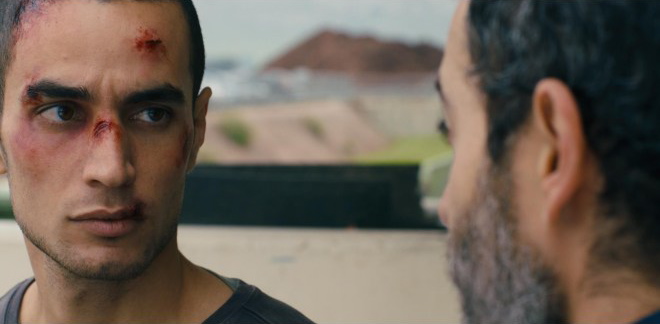
Adam Bakri and Waleed F. Zawaiter in Omar
Obligatory betrayals
Omar is Hany Abu-Assad's first film set in Palestinian territory since Paradise Now eight years ago (NYFF 2005). It's a clean, sharp, chiseled movie, like the look of his handsome and charismatic lead, Adam Bakri, who plays Omar. The issues are not so sharp or clear. In Paradise Now, which also had a stark, definitive look, the two young would be suicide bombing martyrs were muddled about their commitment. This plot is even more tangled. Maybe Omar makes sense if you're a Palestinian living in the territories. To outsiders it may look like game-playing or confusion. I would look further. Everything is relevant to the world depicted. But despite good acting, accomplished, lean filmmaking, and strong material, Omar feels in some ways contrived. And its boundaries are blurred, as shown by the fact that the Separation Wall Omar keeps scaling to see his girlfriend divides not Arabs from Jews, but Palestinians from Palestinians.
There are four young characters (all first-timers). Omar, the brave one, is in love with Nadia (Leem Lubany), the schoolgirl sister of his activist friend Tarek (Eyad Hourani), the adventurer. Together with the small, young jokester Amjad (Samer Bisharat), the pals plan to shoot an Israeli soldier. One of them makes the plan, another steals the car, and the third has to shoot the soldier. When it's done, Omar is captured, beaten, tortured, and released into the prison population, where he tells an undercover informant, "I'll never confess," which to the Israelis is confession enough. But they want the shooter. So the informant, Agent Rami (Waleed F. Zuaiter) offers to get Omar released. If he can point them to Tarek, who they think held the gun, Omar can avoid jail time.
Omar goes back out, but instead of turning in Tarek gets involved in another action he plans to ambush soldiers in a cafe. This goes awry, though, showing that someone is betraying them. Omar is connected with his friends, Nadia, her family. Who is it? Strangely enough, Agent Rami sticks his neck out, so he says, to get Omar released one more time, with a second chance to turn in Tarek.
Now because Omar has been in jail, the community begins to suspect him. Eventually that includes Nadia. Indeed Omar has made a promise to Agent Rami. Is the latter Israeli or Arab? One scene makes that confusing, but may be meant to show how good Israelis are at posing as Palestinians. Finally, it comes out who the opportunist has been. Omar winds up at a dead end, left with nothing but a choice between complicity or a desperate act.
Acting is good, from experienced pro Waleed F. Zuaiter (also producer) on down, particularly the sensitive-faced lead, who as Abu-Assad says, "jumps off the screen." The way Abu-Assad complicates the web of complicity and suspicion by adding love makes Omar seem almost Shakespearean, but hence also more theatrical -- and not at all time-bomb-tense like Paradise Now.. With Omar, this filmmaker has now had the distinction of having two Palestinian films submitted for the Best Foreign Oscar, and Paradise Now was the only Palestinian film actually made a finalist for the award. These are a far cry from the subtle ironies of Elia Suleiman, whose Divine Intervention was the first such submission (2003) I personally wonder if "freedom fighter" AKA "terrorist" acts might be the wrong material for Palestinians to submit, and if the joint Israeli-Palestinian film Ajami (Israeli's 2009 Best Foreign Oscar nominee) isn't a more rounded and human cinematic depiction of the brutal, chaotic world Palestinians live in.
Omar, 93 mins., debuted at Cannes (Un Certain Regard; Jury Prize), and was screened for this review as part of the New York Film Festival at Lincoln Center. The film opened in New York and Los Angeles Fri. 21 Feb. 2014 and A.O. Scott reviewed it in the NY Times, admitting he risked insensitivity in doing so but unable to resist saying that the conflict has been "a boon to ambitious genre filmmaking." Scott noted in this connection that Omar, "tightly plotted and cleanly shot (and an Oscar nominee for best foreign-language film), has the speed and suspense of a crime thriller." He described Omar, the protagonist played by Adam Bakri, as "the sensitive one, handsome and athletic with the soul of a poet."
Last edited by Chris Knipp; 01-02-2015 at 06:17 PM.
-
James Gray: THE IMMIGRANT (2013)
JAMES GRAY: THE IMMIGRANT (2013)
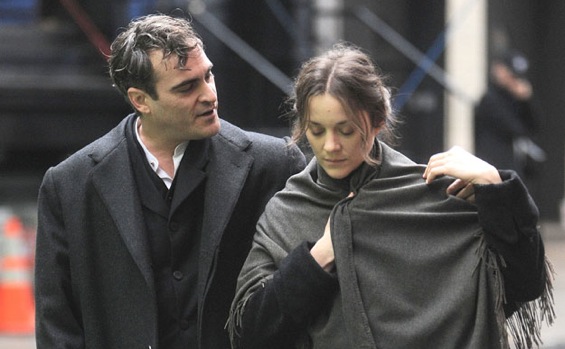
Joaquin Phoenix and Marion Cotillard in The Immigrant
Long slow vicissitudes
James Gray, grandson of Russian Jewish immigrants to New York, has made a film about a Polish Catholic woman in the early Prohibition era who runs afoul of an exploiter who saves her from being deported at Ellis Island in exchange for becoming a prostitute. It's like indentured servitude. Her sister was put in the hospital with TB and -- well, it's a long, sad story. And it's told for us through Marion Cotillard as Ewa, the Polish woman, Joaquin Phoenix as Bruno Weiss, the "impresario," and Jeremy Renner as Bruno's magician cousin, Emil, AKA Orlando. They deliver, especially the ever-soulful Cotillard, who even acts some of her scenes convincingly in Polish. But a story like this should be epic, and intense, and rich in adventures, and Gray's screenplay, cowritten with Ric Menello (who collaborated on his fine Two Lovers) never quite finds tone or momentum. What we get are authentic details, sepia tints, handsome photography and delicate lighting. It's enough to set a mood, almost even cast a spell. But we get nowhere to go with it.
That's the point, of course: Gray takes his time to lovingly create a mood in which a woman is trapped, but has the fortitude and moral strength to survive squalid circumstances. Ewa's behavior on board the ship reportedly was improper (the men were brutal on the unprotected women), and her sister's being quarantined means she must struggle to stay in the country and somehow by nearby to help. Bruno comes along when needed, with undefined connections with Immigration authorities, and gets her released into his care. Both actors are interesting together, Phoenix a mixture of kindly and exploitative, Cotillard a roiling blend of resentment and gratitude. What Gray's aiming at is a portrait of forgiveness. He's said that's why he chose to focus on a Catholic woman rather than the Jews of his own family. He's interested in compromises and moral complexity and the willingness to acknowledge indebtedness even when the benefactor had questionable motives.
This, of course, isn't an action movie. A return to Ellis Island to see Ewa's sister, with a magic show (meaningfully involving levitation) involving the cousin (Renner) and singing performance by Caruso, and a couple of abortive trips by Ewa to her aunt in Brooklyn; even dramatic fights between Emil and Bruno, who begin to compete for Ewa's attentions, still don't keep the placid trajectory from seeming a bit tame and static. In a way Gray is still thinking in the dualistic terms of Two Lovers. And maybe he ought to have stayed more that way, instead of introducing the competition for Ewa between Phoenix and Renner. The latter hasn't the heft of Phoenix as a personality, and though his fly-by-night character, a trickster and gambler who yet claims to be more of a decent fellow, is a new departure for Renner and interesting casting, the subplot just seems like a distraction.
People are saying this affirms Gray's classicism as a filmmaker inspired by golden decades of Hollywood (the Fifties? Seventies?), but his old-fashioned-ness had more sex appeal when he dealt with gangsters. Cotillard can never do wrong and Joaquin Phoenix remains an actor with an odd unexpected edge, but this seems like simply an impressive-looking wrong turn.
The Immigrant, 120 mins., debuted at Cannes May 2013, with subsequent showings at a number of international film festivals, including New York, at Lincoln Center where it was screened for this review. Theatrical release scheduled for various countries, including France 27 Nov, 2013. Limited US release began 16 May 2014.
Last edited by Chris Knipp; 01-02-2015 at 06:20 PM.
-
Claire Denis: BASTARDS (2013)
CLAIRE DENIS: BASTARDS (2013)
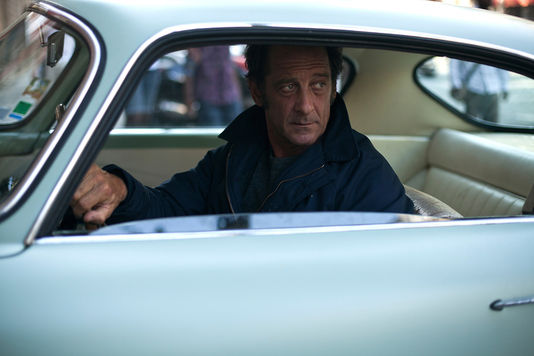
Vincent Lindon ant the pretty Alfa Romeo in Bastards
Pleasing mystification not so good when it comes clear?
This is one of Denis's puzzlers, like The Intruder, except it's not that pleasurably mysterious, and lacks its vigorous, tonic physicality, unless you call moments of sex and violence that. Many of the usual players are there, with Vincent Lindon of Friday Night in the foreground throughout, Michel Subor as a morally dubious rich man again, Alex Descas of 35 Shots of Rum, and others seen before, including Grégoire Colin, seen almost always. Actually while it provides few points of obvious reference, up to a point Bastards is easy to explain compared to The Intruder. A ship's captain, Marco Silvestri (Lindon) comes back to find his family is losing their shoe factory and has been involved in some ugly corruption (drugs, sex) that he didn't know about. He occupies a nearly empty flat in a nice ("Haussmanian") building -- to observe dubious magnate Edouard Laporte (Subor), and start screwing Laporte's mistress Raphaëlle (Chiara Mastroianni), with whom she shares a little boy, "little Joseph" (Yann Antoine Bizette).
Other characters include Marco's sister Sandra (Julie Bataille); whose husband Jacques (Laurent Grevill) commits suicide in the opening scene, being massively in debt to Laporte; and a young woman, evidently their daughter Justine (Lola Créton), traumatized by devious practices, who wanders the streets at night stark naked except for high heels. She has been in the care of a Dr. Béthanie (Descas), who's also a psychiatrist. Involved in a scene of orgies out in the country, which Marco visits, are several people glimpsed fleetingly, including Xavier (Colin). Marco's behavior is mysterious. He sells a valuable watch, and then to a friend and former naval associate who collects cars, he sells his pretty robin's egg blue Alfa Romeo. Evidently he has taken time off to help his sister deal with the debuts, and to observe Laporte. These elements accumulate by an achronological precess of accretion rather than conventional narrative flow.
Various cool, mysterious, vaguely exciting, and eventually disquieting things go on that may be more interesting when we don't yet understand what they are. The view of Mike D'Angelo, who saw the film when it debuted in Un Certain Regard at Cannes, is that it can be compared to Assayas' Demonlover, also related to corporate evil and devious sex, also cool, but mundane when it reveals its secrets toward the end. D'Angelo points out this is loosely based on Faulkner's Sanctuary. He recounts some hocus-pocus having to do with a bar of soap and a shirt, and the repair of the boy's bike used as an intro between Marco and Raphaëlle. D'Angelo concludes, "while Bastards is never less than enthralling while it unravels, its resolution—again, like that of Demonlover—feels shallowly sordid, as if the entire movie was really just a prolonged moralistic scold cleverly disguised as something richer and more mysterious." And he thinks this will be a footnote to Denis' main filmography, which follows, if his analysis is right. Her collaborator on the writing, as on a number of occasions, was Jean-Pol Fargeau.
This is probably a film that's more fun to analyze than watch, though it also, like The Intruder, will probably be more enjoyable after being more thoroughly worked through. Scott Foundas in Variety, who seems enthusiastic, also notes a link to Kurosawa's The Bad Sleep Well. He describes this as a "hypnotic nocturnal thriller" that exercises a "dreamlike pull." Les salauds (the original title) opened in France in August, where it has mixed press (Allociné 2.9), due to a split between the hipper, more sophisticated journals cited (Les Inrocks, Cahiers) that appreciated and the more mainstream (Le Monde, Télérama) that didn't at all. Even Cahiers found the final explanatory sequence irrelevant and thought it would be more artistically pure without it: why be mysterious and elusive and then explain things? This is probably what D'Angelo's bothered by. Music by usual collaborators Stuart A. Staples and British indie outfit Tindersticks is excellent. Shot by Agnès Godard as usual but in digitial this time.
Bastards/Les salauds, 83 mins., debuted at Cannes May 2013, opened in France 7 Aug., screened for this review as part of the New York Film Festival at Lincoln Center; opens NYC 23 Oct.
Last edited by Chris Knipp; 01-02-2015 at 06:43 PM.
 Posting Permissions
Posting Permissions
- You may not post new threads
- You may not post replies
- You may not post attachments
- You may not edit your posts
-
Forum Rules





 Reply With Quote
Reply With Quote






Bookmarks